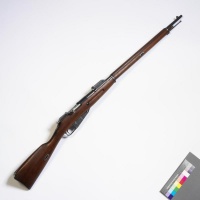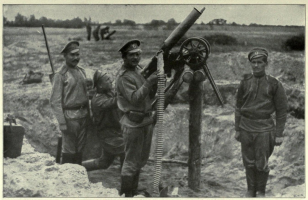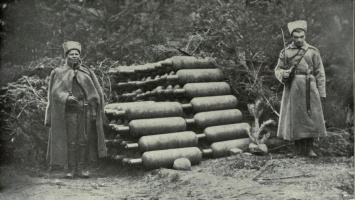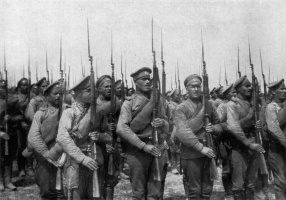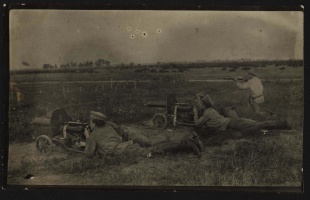Introduction↑
The story of Russia's effort to wage war between 1914 and 1917 is generally well-known. According to the standard narrative, the Empire of the Tsars entered the First World War in August 1914 among the least technologically developed and, thus, most "backward" of the major belligerents, fated to succumb to the German Empire – its more advanced and, thus, more "modern" major adversary. Despite fielding the largest army Europe had ever seen, inadequate transportation and communications networks, incompetent leadership, and insufficient productive capacity hamstrung the efforts of Russian soldiers and civilians to cope with history's first "Total War."[1] The combination of technological backwardness and strategic ineptitude proved disastrous. Economic and political strains induced by the conflict heightened longstanding tensions in Russian society. In the face of recurrent military defeats and mounting domestic distress, revolutionary dissent spread, contributing to the collapse of the autocracy in February 1917 and, soon thereafter, the Bolshevik seizure of power. The country's formal exit from the conflict in March 1918 via the Brest-Litovsk Peace brought an ignominious end to Russia's involvement with the Western Allies. It also marked the beginning of an even more destructive period of civil war, disease, and famine from which the world's "first socialist state," the USSR, would emerge.
More recent scholarship on Russia's Great War and Revolution has focused attention on the many ways in which Russia's wartime history, while tragic, was not fundamentally different from that of other belligerent nations involved in the conflict. The war's unexpected nature and unprecedented scope strained the organizational and productive capacities of even the most advanced European states. Governments across Europe (and the United States) responded by adopting policies that centralized their economies and militarized their societies to expand the state's ability to meet wartime demands. The tsarist government, as Peter Holquist, Joshua Sanborn, and others have noted, acted in a comparable fashion.[2] Its measures were not entirely without success. Andrei Markevich, Mark Harrison, and Peter Gatrell have demonstrated that Russia's wartime economy developed more dynamically than scholars previously believed.[3]
Among the few aspects of Russia's wartime experience not subject to broad scholarly reassessment are those involving science and technology. Though individual essays and chapters devoted to specific topics have appeared, there are no book-length monographs devoted to Russian science and technology during the war. To a certain extent, this is understandable. Against the catastrophic backdrop of global conflagration, mass violence, and the pursuit of political utopia, the story of Russia's wartime technical and scientific efforts may appear somewhat marginal. Despite significant contributions in decades past by founders of the sub-field including Alexander Vucinich, Loren Graham, Kendall Bailes, and Bruce Parrott, the history of Russian science and technology remains understudied. Only recently has a new generation of scholars begun to re-focus attention on science and technology as essential to understanding the Russian past.[4] This essay draws upon a range of established and more recent scholarly works in describing key Russian technological and scientific developments before and during the Great War.
Russia on the Eve of War↑
The quarter century preceding 1914 was a period of considerable growth and progress for Russian science and technology. Although the country still trailed its Western rivals in terms of the breadth and depth of its intellectual and material reserves, its continuing status as a technical and scientific "laggard" was more a product of unparalleled foreign dynamism than the failure of domestic state and social leaders to focus attention on developmental needs. The two generations bound up between the 1870s and the start of the war were marked by a staggering array of Western scientific and technological advances. Most noteworthy were those involving electricity, steel, and the internal combustion engine. Together with the advent of the modern petroleum and chemical industries, the new products and processes associated with the "Second Industrial Revolution" profoundly altered human experience and shaped the contours of the 20th century.[5]
Russia's considerable challenge was how to incorporate and diffuse these newly emergent systems at the same time it was experiencing its first industrial "take-off." A concerted effort on the part of government ministers after 1890 to expand the Empire's industrial base and thereby boost productive capacity, coupled with a frenetic campaign of railroad development, put Russian industrialization on the fast track at the end of the 19th century. Between 1860 and 1913, large-scale industrial production in Russia expanded by a factor of eleven. On the eve of the war, approximately 21 percent of the Empire's net income was derived from industrial manufacturing. Because of rapid population growth and the country's significantly less productive, unskilled labor force, Russian industrial production remained very low when measured on a per capita basis (roughly 10 percent that of France and 7 percent that of Great Britain and the United States). Increasing mechanization, facilitated by the importation of modern machines and tools from the West, only partially offset lingering deficiencies.[6] All the same, Russia experienced impressive gains between 1885 and 1914. Its annualized economic growth of 3.25 percent during the period was among the strongest in Europe.[7]
Russia's scientific and technical progress in the immediate pre-war period was evident in the growth of its transportation and communications capacities. Between 1908 and 1914, a feverish program of construction directed at shoring up the military's mobilization infrastructure significantly expanded the country's rail network along its frontiers with Germany and Austria-Hungary. By August 1914, the Empire boasted some 72,935 kilometers of railway lines (excluding Finland) – well more than double the approximate 30,500 kilometers of track in 1890.[8] Owing to its vast size and large population, however, Russia's rail system remained significantly smaller relative to those in every other major European state. Moreover, three-quarters of the Empire's network comprised single-track lines which complicated logistics, slowed transportation speeds, and contributed to bottlenecks across the system. Russia's most impressive technical accomplishment during the period, the construction of the more than 9,000 kilometer-long trans-Siberian railway, had come at staggering cost and amid considerable financial mismanagement and waste.[9]
Much like the railroads, the development of Russia's communications network was marked by impressive gains and lingering deficiencies. In the decade preceding the start of the war, the country added as many new telegraph lines as it had constructed during the previous forty years.[10] As of 1913, the Empire possessed some 229,292 kilometers of line served by 11,133 machines.[11] Still, capacity to transmit information between major urban centers and across its hinterlands remained limited. The introduction of telephone service during the 1880s and 1890s by the American Bell Telephone Company and, later, the Swedish firm L.M. Ericsson and Co., had a limited impact. Close to 12.5 million urban and 18.1 million rural inhabitants resided in areas served by telephones in 1913, but few networks extended beyond the vicinity of the city or township in which they were based. Inter-urban phone service was rare; access to the technology was not wide-spread. Whereas on the eve of the war, France had one telephone for every 150 people, the United Kingdom and Germany had one for about every sixty, and the United States had one for every ten, the ratio in Russia hovered around one telephone for every 1,000 of the tsar's subjects.[12]
The years leading up to the First World War were also marked by advances in Russian military technology. In the wake of the humiliating defeat suffered in the Russo-Japanese War (1904-1905), the autocracy embarked on a campaign of military modernization. Improvements to the country's railroad and communications network (noted above) were constituent elements of this, as was the modernization of Russian artillery and firearms. With regard to the former, collaboration in the 1880s and 1890s between domestic armaments factories and foreign producers (including the German Krupp, French Schneider-Creusot, and British Vickers firms) enhanced the quality of Russian field artillery and significantly expanded the production capacity of domestic manufactures such as the St. Petersburg-based Putilov Company.[13] The development of the bolt-action Mosin field rifle in conjunction with the Belgian arms manufacturer Nagant was similarly significant. Introduced to the ranks in 1891, variations of the Mosin rifle would serve as the principal weapon of the Russian (and later Soviet) infantry until the end of the Second World War.[14]
Among the various technological developments, the dawning age of aviation had the greatest long-term significance for the Russian armed forces. Following Louis Blériot's (1872-1936) flight across the English Channel in July 1909, widespread public interest in (and military concern about) “heavier-than-air travel” led Nicholas II, Emperor of Russia (1868-1918) to commit close to 1 million rubles to the construction of a military air wing. Soon thereafter, the government launched a voluntary subscription campaign to raise funds for the purchase of airplanes and the training of pilots. By the summer of 1914, Russia boasted an air force second only to France in terms of the number of aircraft. Though most of these machines were obsolete models built under foreign licenses by domestic manufacturers, native Russian aircraft designers demonstrated considerable skill in the emerging "science of the air." Among them, Igor Sikorsky (1889-1972) was the most prominent. In early 1913, he constructed the world's first multi-engine airplane. A second, more airworthy plane, the "Ilya Muromets," debuted later that same year. By the war's end, seventy-three additional "Muromtsy" would be constructed, giving Imperial Russia history's first long-range strategic air arm.[15]
As in earlier periods, the material resources and innovative techniques necessary to sustain these technological developments mostly came from abroad. Foreign businesses, entrepreneurial investors, and other "pioneers for profit" provided outside investment capital or, alternatively, worked to mobilize domestic sources to raise the funds that promoted modernization. Equally important, foreign business interests played prominent roles in the importation of advanced technical tools and systems. Their contributions jumpstarted emerging new industrial enterprises (such as electric generation, urban tramway production, and fledgling automotive and aeronautical ventures) as well as enhanced lagging sectors (including metallurgy, glass production, and mining) which had failed to keep pace with the rapid innovations occurring abroad.[16]
Russian dependence on foreign suppliers was particularly problematic in scientific and high technology fields which would prove critical to wartime production. Material shortages were pronounced in pharmaceuticals, oil refining, explosives, dyeing and, above all, chemical manufacturing, where more than half of the essential raw materials had to be imported from abroad.[17] The Empire lacked domestic supply sources for aluminum, nickel, and tin. Its electrical engineering sector relied on foreign suppliers for more than a third of its production needs. Its dependence was even greater for critical items such as high voltage transformers and incandescent lamps.[18] Though capable of producing chassis and airframes, automobile and aviation manufacturers struggled to produce reliable engines, necessitating their importation from Western firms. As late as 1913, most of the country's textile machinery and steam engines came from abroad as did more than two-thirds of its machine tools.[19]
Russia's dependence on external suppliers for meeting the needs of its expanding technical and scientific infrastructure was not, however, absolute. During the decade or so preceding 1914, the country demonstrated a growing capacity to generate the human resources prerequisite to the establishment of its own technical and scientific sectors. Increasingly, even foreign-owned and operated enterprises came to rely upon Russian experts to serve as in-country directors and managers. By 1914, only a handful of foreign nationals remained in supervisory positions in the Empire's leading enterprises. These advances were made possible thanks to expanding educational opportunities in scientific and technical fields. At the dawn of the 20th century, the opening of new polytechnic institutes in Kiev (1898), Warsaw (1898), and St. Petersburg (1902), together with the establishment of a new mining academy in Ekaterinoslav (1899) and a technological institute in Tomsk (1900), contributed to a 300 percent increase in the number of students attending technical academies (from 7,534 in 1899 to 24,807 in 1913). These numbers remained quite low for a country of 170 million inhabitants, but the growing ranks of domestically trained engineers and technicians were generally sufficient to meet the needs of industry.[20] No less important, they came to comprise a native technical and scientific "intelligentsia" whose expertise would prove crucial following the start of the First World War.
Russian Science and Technology at War↑
The outbreak of war laid bare the importance of foreign materiel in sustaining Russian industrial, technological, and scientific systems. Soon after the onset of hostilities in August 1914, chaos erupted across most industrial sectors as factories and enterprises struggled to obtain indispensable foreign commodities and replacement parts. The critical situation was compounded by the government's failure to adequately prepare in the run-up to war and its slow response once fighting began. Notwithstanding expectations dating back several years regarding a looming showdown with Germany and Austria-Hungary, no plans had been made for the wartime mobilization of Russian industry. Tsarist state ministers, like their counterparts elsewhere in Europe, were convinced the conflict would be short and thus did not anticipate a major munitions program, or foresee the need to expand Russia's military industrial capacity.
By early 1915, shortages of artillery shells, rifles, engines, machine tools, chemicals, and a host of other essential items threatened the government’s ability to prosecute the war. Alarmed by the mounting procurement crisis, patriotic business leaders took the initiative in the spring of 1915 to establish war-industry committees in the hopes of better integrating small and medium-scale enterprises into military production, while rationalizing the allocation of available resources and expanding industrial output. Soon thereafter, the government responded with its own Special Council for State Defense (OSO) to coordinate with the war-industry committees, secure supplies from allied and neutral countries, and impose greater central control over the nation's transport, fuel, and food supply sectors. Despite its title, the OSO did not become an all-encompassing or coordinating body. Bureaucratic turf wars with existing state ministries compromised the new council's effectiveness.[21] Still, the belated mobilization of manufacturing coupled with massive increases in the defense budget significantly raised Russian industrial production relative to its peacetime levels in 1913.
The performance of the nation's transportation network typified the successes and setbacks experienced across Russia's wartime industrial sectors. As in other belligerent nations, rail traffic initially declined following the onset of hostilities as factory shipments and commercial transactions were cancelled to make way for the mobilization of men and armaments. Transport subsequently reached record levels in 1915 and 1916, placing considerable strain across the entire network. In short order, bottlenecks and long delays began contributing to shortages of food and fuel in urban centers. With access through the Baltic Sea cut off by Germany's naval blockade, the far northern port of Arkhangel'sk and Vladivostok in the Far East became the primary conduits for international trade and commerce. The former was only accessible via a low-capacity, single-track, narrow-gauge line (converted to standard Russian gauge only in 1916), while the latter suffered from the much higher costs and slower travel times associated with the recently completed trans-Siberian route. As the war progressed, new lines were laid and orders for new engines and rolling stock (foreign and domestic) were increased to expand capacity and to compensate for extraordinary wear and tear on an overloaded infrastructure. A growing sense of crisis led the short-lived Provisional Government to approve foreign orders for 2,000 engines and 40,000 wagons in mid-1917. However, the few shipments which eventually arrived in country came far too late to affect the war's outcome.[22]
While Russian industry never fully adjusted to the scale and complexity imposed by total war, overall output increased during the course of the conflict (though not enough to meet the nation's needs). By 1916, the country's annual output of rifles had expanded nearly fourfold; machine gun production was thirteen times higher; a nascent aviation industry had come into being; military vehicles were being produced for the first time; and mass manufacturing techniques and the use of interchangeable parts had become more widespread.[23] Overall, however, the country's technical and industrial sectors proved too weak and disorganized to deliver the advanced equipment necessary to operate a modern, multi-million-soldier strong army in the field. During the course of the war, Russia imported upwards of one-fifth of its bullets, two-fifths of its rifles, and three-fifths of its machine guns, airplanes, and motors.[24]
Though Russian factories struggled to blend newer techniques with the longstanding practices employed by their technically illiterate and semi-skilled workforces, new scientific and technical advances were made in isolated sectors.[25] Sikorsky's aforementioned "Ilya Muromtsy" is one case in point (though rapid advances in Western airframe and engine design made the Russian aircraft obsolete by 1917). Wartime progress in chemical manufacturing is likewise noteworthy. Confronted with difficulties in arranging the foreign purchase of large quantities of toluene and benzol (key components in the manufacture of munitions and explosives), procurement officials ordered the construction of Russia's first state benzol plant in 1915. Subsequently, additional factories devoted to the production of essential chemical compounds were brought on line. These steps marked the establishment of a domestic Russian chemical industry. Following the first German chemical weapons attack on Russian troops near Warsaw in May 1915, the Chief Artillery Administration ordered the formation of a "Special Commission on Poison Gases" to conduct research on the production and weaponization of chlorine and phosgene. Concurrent research and development of "passive chemical warfare" undertaken by civilian chemists at Moscow University led to the production of gas masks. By the war's end, the country's factories would produce approximately 15 million gas masks of several different types.[26]
The most portentous development in wartime Russian science and technology involved a significant expansion in the numbers of trained specialists and their growing emphasis on practical research. The closing of the country's border to Germany not only cut off industrial supplies and spare parts, but also ruptured important communication channels between Russian technicians and scientists and their colleagues abroad. The resulting intellectual and institutional isolation lasted until the consolidation of Bolshevik power in the early 1920s. In the interim, members of the country's technical intelligentsia looked to support the war effort by making proposals to state and industrial leaders to have their own work shifted toward utilitarian ends. In this sense, the First World War marked a major transformation in the attitudes of Russian specialists toward the nature and purpose of scientific research. Prior to 1914, academics had emphasized the value of theoretical (or "pure") science at the expense of practical applications. A patriotic desire to contribute to the war effort resulted in growing numbers advocating the development of new research agendas and specialized institutes useful to industry and manufacturing.[27]
Members of the Russian Academy of Science played a prominent role in these efforts. As business leaders and state officials responded to the procurement crisis by forming special committees and councils, academy members likewise moved to establish the Commission for the Study of Scientific-Productive Forces (KEPS). Aimed at mobilizing scientists and engineers to pursue applied research and development, the commission examined close to two dozen proposals for the creation of specialized institutes devoted to practical scientific and technical research.[28] Although a lack of funding prevented any of these projects from being realized before the war's end, the experience of KEPS set the stage for the greater emphasis on state planning and support for applied military research which dominated Russian science and technology in the post-war, Bolshevik period.
No less important, the ranks of the country's "technical intelligentsia" grew considerably during the war as employment opportunities for engineers, agronomists, doctors, medical auxiliaries (fel'dshery), and others engaged in technical or scientific activities expanded rapidly. Between 1913 and 1917, the number of engineers and technicians working in factories and industrial enterprises increased by more than a third. Growth was similarly impressive in the machine building sector which saw a near doubling of those engaged in designing and constructing tools utilized by industry.[29] Drawn mostly from the ranks of the non-noble classes and trained in the polytechnic institutes established in the decades prior to the war, these individuals comprised the generation of so-called "bourgeois" specialists (spetsy) who would be called upon to implement technical and scientific policy following the consolidation of Bolshevik power.
Conclusion↑
Despite considerable progress during the decades before the First World War, Russia remained heavily dependent upon foreign firms for the equipment, expertise, and materiel necessary to modernize its expanding industrial sectors. Far from revealing the crippling effects of technological and scientific "backwardness," however, the onset of hostilities in August 1914 demonstrated that the Empire possessed considerable capacity to meet the unprecedented demands of an unexpected "total war."
Russian state and society responded to the First World War along much the same lines as their counterparts in European states: industrial production was greatly expanded; more centralized economic planning was instituted, and new agencies were established to coordinate the activities of military, state, and civilian actors. While these steps did not result in victory, they were sufficient to mobilize and sustain the efforts of an unprecedented 15 million soldiers through three-and-a-half years of industrialized warfare. Along the way, manufacturing output increased to levels previously unmatched in the country's history; transport capacity expanded; new industries were created; the ranks of technical and scientific specialists swelled; and the institutional foundations for applied scientific and technical research were established. While many of these gains appeared to have been lost during the murderous Russian Civil War which followed, their re-emergence in the aftermath of the Bolsheviks' consolidation of power testifies to the war's lasting and transformative effect on Russian science and technology.
Scott W. Palmer, Western Illinois University
Section Editors: Boris Kolonit͡skiĭ; Nikolaus Katzer
Notes
- ↑ See, for example, the classic accounts by Bernard Pares and Michael T. Florinsky: Pares, Bernhard: The Fall of the Russian Monarchy: A Study of Evidence, New York 1961; Florinsky, Michael T.: The End of the Russian Empire, New York 1961.
- ↑ Holquist, Peter: Making War, Forging Revolution. Russia's Continuum of Crisis, 1914-1922, Cambridge, MA 2002; Sanborn, Joshua: Drafting the Russian Nation: Military Conscription, Total War, and Mass Politics, 1905-1925, DeKalb 2002.
- ↑ Markevich, Andrei/Harrison, Mark: Great War, Civil War, and Recovery. Russia's National Income, 1913 to 1928, in: Journal of Economic History 73/1 (2011), pp. 672-703; Gatrell, Peter: Russia's First World War. A Social and Economic History, Harlow 2005.
- ↑ On this, see Palmer, Scott W.: Technology Defines Everything, in: The Russian Review 70/3 (July 2011), pp. 371-379.
- ↑ Smil, Vaclav: Creating the Twentieth Century. Technical Innovations of 1867-1914 and Their Lasting Impact, New York 2005; Hughes, Thomas P.: American Genesis: A Century of Invention and Technological Enthusiasm, 1870-1970, Chicago 1989.
- ↑ Dowler, Wayne: Russia in 1913, DeKalb 2011, pp. 38-39.
- ↑ Gregory, Paul R.: Russian National Income, 1885-1913, Cambridge 1982, pp. 55-56.
- ↑ Anfimov, A. M. et al. (eds.): Rossiia. 1913 god. Statistiko-dokumental'nyi spravochnik [Russia, 1913: Statistical-documentary Directory], St Petersburg 1995, p. 109.
- ↑ Marks, Steven G.: Road to Power: The Trans-Siberian Railroad and the Colonization of Asian Russia, 1850-1917, Ithaca 1991.
- ↑ Psurtev, N. D.: Razvitie sviazi v SSSR [The Development of Communications in the USSR], Moscow 1967, p. 31.
- ↑ Anfimov, Rossiia 1995, p. 146.
- ↑ Smil, Creating the Twentieth Century 2005, pp. 235-236.
- ↑ Kirchner, Walther: One Hundred Years Krupp and Russia, 1818-1918, in: Vierteljahrschrift für Sozial- und Wirtschaftsgeschichte 69 (1982), pp. 98-100; Grant, Jonathan A.: Big Business in Russia: The Putilov Company in Late Imperial Russia, 1868-1917, Pittsburgh 1999.
- ↑ See, Bradley, Joseph: Guns for the Tsar: American Technology and the Small Arms Industry in Nineteenth-Century Russia, DeKalb 1990, pp. 169-171.
- ↑ Palmer, Scott W.: Dictatorship of the Air: Aviation Culture and the Fate of Modern Russia, Cambridge 2006, pp. 18-23 and 55-58. See also, Palmer, Scott W.: The Russian Origins of Strategic Air Operations, issued by: Russia's Great War and Revolution, online: http://russiasgreatwar.org/media/military/air_operations.shtml (retrieved: 14 February 2017).
- ↑ McKay, John P.: Pioneers for Profit. Foreign Entrepreneurship and Russian Industrialization, 1885-1913, Chicago 1970.
- ↑ Gatrell, Russia's First World War 2005, pp. 122-123; Grinevetskiy, V. I.: Poslevoyennyye perspektivy Russkoi promyshlennosti [Post-War Perspectives on Russian Industry], Kharkov 1922, p. 33.
- ↑ Coopersmith, Jonathan: The Electrification of Russia, 1880-1926, Ithaca 1992.
- ↑ Gatrell, Peter: Government, Industry, and Re-armament in Russia, 1900-1914. The Last Argument of Tsarism, Cambridge 1994, p. 309.
- ↑ Bailes, Kendall: Technology and Society under Lenin and Stalin. Origins of the Soviet Technical Intelligentsia, 1917-1941, Princeton 1978, p. 27 and 36.
- ↑ Gatrell, Russia's First World War 2005, pp. 43-46 and 91-92.
- ↑ Heywood, Anthony: Modernising Lenin's Russia. Economic Reconstruction, Foreign Trade and the Railways, Cambridge 1999, pp. 24-25 and 46-47.
- ↑ Gatrell, Russia's First World War 2005, pp. 119-122.
- ↑ Adelman, Jonathan R.: Prelude to the Cold War: Tsarist, Soviet, and U.S. Armies in the Two World Wars, Boulder 1988, p. 36 and Gatrell, Russia’s First World War 2005, p. 126.
- ↑ Gatrell, Peter: The Tsarist Economy, 1850-1917, New York 1986, p. 186.
- ↑ Kojevnikov, Alexei: The Great War, the Russian Civil War, and the Invention of Big Science, in: Science in Context 15:2 (2002), pp. 245-247.
- ↑ Kojevnikov, The Great War 2002, pp. 240-242.
- ↑ Bailes, Technology and Society 1978, pp. 40-41.
- ↑ Ibid., p. 47.
Selected Bibliography
- Adelman, Jonathan R.: Prelude to the Cold War. The Tsarist, Soviet, and U.S. armies in the two world wars, Boulder 1988: L. Rienner.
- Anfimov, Andrei Matveevich / Korelin, Avenir Pavlovich (eds.): Rossiia. 1913 god. Statistiko-dokumental'nyi spravochnik (Russia, 1913. Statistical-documentary directory), St. Petersburg 1995: Blits.
- Bailes, Kendall E.: Technology and society under Lenin and Stalin. Origins of the Soviet technical intelligentsia, 1917-1941, Princeton 1978: Princeton University Press.
- Bradley, Joseph: Guns for the tsar. American technology and the small arms industry in nineteenth-century Russia, DeKalb 1990: Northern Illinois University Press.
- Dowler, Wayne: Russia in 1913, DeKalb 2010: Northern Illinois University Press.
- Gatrell, Peter: Government, industry, and rearmament in Russia, 1900-1914. The last argument of tsarism, Cambridge; New York 1994: Cambridge University Press.
- Gatrell, Peter: Russia's First World War. A social and economic history, Harlow 2005: Pearson/Longman.
- Grant, Jonathan A.: Big business in Russia. The Putilov Company in late Imperial Russia, 1868-1917, Pittsburgh 1999: University of Pittsburgh Press.
- Gregory, Paul R.: Russian national income, 1885-1913, Cambridge; New York 1982: Cambridge University Press.
- Grinevetskiy, V. I.: Poslevoyennyye perspektivy Russkoi promyshlennosti (Post-war perspectives on Russian industry), Kharkov 1922.
- Heywood, Anthony: Modernising Lenin's Russia. Economic reconstruction, foreign trade and the railways, 1917-1924, Cambridge; New York 1999: Cambridge University Press.
- Holquist, Peter: Making war, forging revolution. Russia's continuum of crisis, 1914-1921, Cambridge 2002: Harvard University Press.
- Hughes, Thomas Parke: American genesis. A century of invention and technological enthusiasm, 1870-1970, New York 1989: Viking.
- Ipatieff, Vladimir N.: The life of a chemist. Memoirs of Vladimir N. Ipatieff, Stanford; London 1946: Stanford University Press; G. Cumberlege; Oxford University Press.
- Ivanova, L. V.: Formirovanie sovetskoi nauchnoi intelligentsii, 1917-1927 (The formation of the Soviet scientific intelligentsia, 1917-1927), Moscow 1980: Nauka.
- Kirchner, Walther: One hundred years Krupp and Russia, 1818-1918, in: VSWG: Vierteljahrschrift für Sozial- und Wirtschaftsgeschichte 69/1, 1982, pp. 75-108.
- Kojevnikov, Alexei: The Great War, the Russian Civil War, and the invention of big science, in: Science in Context 15/2, 2002, pp. 239-275.
- Kolchinskii, Eduard Izrailevich / Beyrau, Dietrich (eds.): Nauka, tekhnika, i obshchestvo Rossii i Germanii vo vremia Pervoi Mirovoi Voiny (Science, technology, and society in Russia and Germany during the First World War), St. Petersburg 2007: Nestor-Istoriia.
- Markevich, Andrei; Harrison, Mark: Great War, civil war, and recovery. Russia's national income, 1913 to 1928, in: The Journal of Economic History 71/3, 2011, pp. 672-703.
- Marks, Steven G.: Road to power. The Trans-Siberian railroad and the colonization of Asian Russia, 1850-1917, Ithaca 1991: Cornell University Press.
- McKay, John P.: Pioneers for profit. Foreign entrepreneurship and Russian industrialization, 1885-1913, Chicago 1970: University of Chicago Press.
- Muzrukova, Elena B. (ed.): Nauka i tekhnika v pervye desiatiletiia sovetskoi vlasti. Sotsiokul'turnoe izmerenie (1917-1940) (Science and technology in the first decades of Soviet power. The sociocultural dimension (1917-1940)), Moscow 2007: Academia.
- Palmer, Scott W.: Technology defines everything, in: The Russian Review 70/3, pp. 371-379.
- Palmer, Scott W.: Dictatorship of the air. Aviation culture and the fate of modern Russia, Cambridge; New York 2006: Cambridge University Press.
- Psurtsev, N. D. / Vlasov, Mikhail Andrianovich: Razvitie sviazi v SSSR, 1917-1967 (The Development of Communications in the USSR, 1917-1967), Moscow 1967: Sviaz'.
- Rozenfelʹd, Ia. S. / Klimenko, Konstantin Ivanovich: Istoriia mashinostroeniia SSSR. S pervoi poloviny XIX v. do nashikh dnei (The history of Soviet mechanical engineering. From the first half of the 19th century to the present day), Moscow 1961: Izd-vo Akademii nauk SSSR.
- Sanborn, Joshua A.: Drafting the Russian nation. Military conscription, total war, and mass politics, 1905-1925, DeKalb 2003: Northern Illinois University Press.
- Smil, Vaclav: Creating the twentieth century. Technical innovations of 1867-1914 and their lasting impact, Oxford; New York 2005: Oxford University Press.







